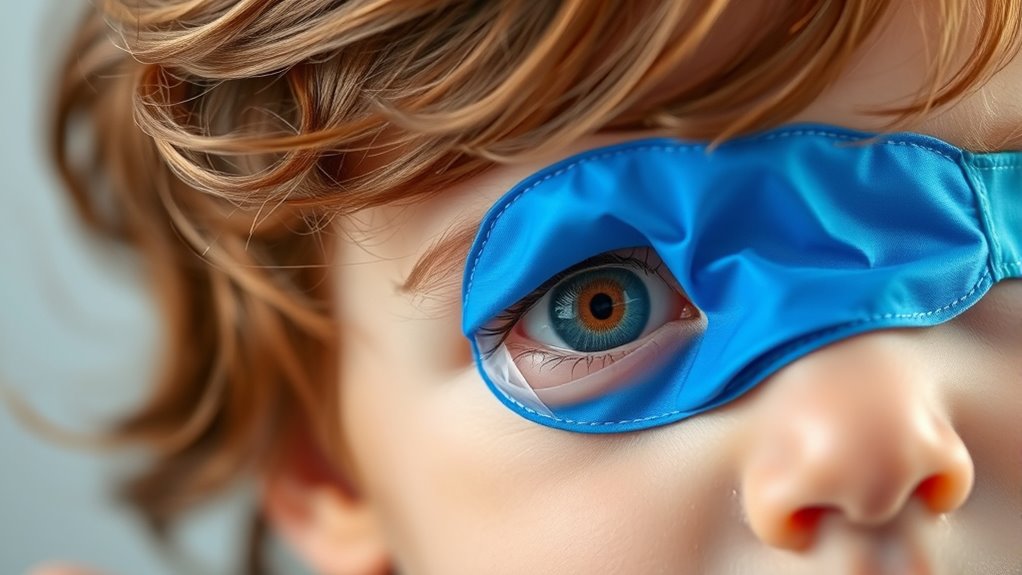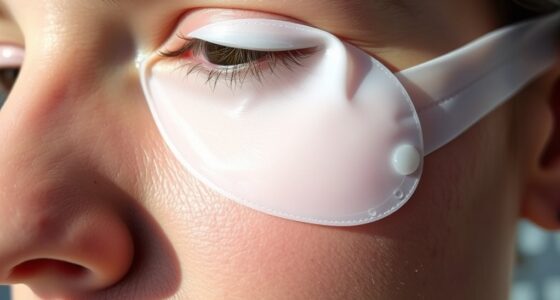You should avoid wearing an eye patch for more than 2 to 4 hours at a time, as extended wear can cause dryness, irritation, and skin problems. It’s important to follow your eye care professional’s instructions and remove the patch once you notice discomfort or itchiness. Proper duration helps protect your eye health while supporting recovery. If you want to learn more about safe patching practices and how to prevent complications, keep exploring this topic.
Key Takeaways
- Limit eye patch wear to 2-4 hours per session, especially for children or specific conditions.
- Wearing patches beyond 4 hours increases risks of dryness, irritation, and skin issues.
- Remove the patch if the eye feels uncomfortable, itchy, or painful during use.
- Proper application and hygiene are essential to prevent infections and skin irritation.
- Follow healthcare provider instructions for duration to ensure safe, effective treatment outcomes.

Wearing eye patches can be an effective part of your eye care routine, but it’s important to know the safe duration for wearing them each day. Proper patch application is crucial not only for comfort but also to protect your ocular health. If you wear an eye patch for too long, you risk causing unintended damage or irritation, so understanding the recommended wear times helps you avoid these issues.
Wearing eye patches safely requires understanding recommended durations to protect your eye health and prevent irritation.
When you start patching your eye, you might wonder how long you should keep it on. Generally, the goal is to give your eye enough time to recover or rest without overdoing it. Most eye care professionals suggest limiting patch application to around 2 to 4 hours at a time, especially for children or individuals with specific eye conditions. Extended wear beyond this can lead to problems like dryness, irritation, or even more serious issues like skin breakdown around the eye area.
It’s important to listen to your body during patching. If your eye feels uncomfortable, itchy, or painful, it’s a sign you need to remove the patch and consult your eye doctor. Overwearing an eye patch can also disrupt natural ocular health by causing the patched eye to become overly dry or by increasing the risk of infection if the patch isn’t kept clean. Proper hygiene and correct application are essential to prevent complications. When applying the patch, ensure it covers the eye completely without putting too much pressure on the eyelid or surrounding skin. This careful patch application helps maintain ocular health and prevents unnecessary discomfort.
Additionally, using appropriate patch materials can help reduce the risk of skin irritation and improve comfort during wear. You should also consider the purpose of your patching. For instance, if you’re patching to treat amblyopia (lazy eye), your doctor might recommend specific durations tailored to your needs. In such cases, adhering strictly to these guidelines is vital. If you’re using a patch for protection after an injury or surgery, your healthcare provider will give you instructions on how long to keep it on to support healing without causing additional strain.
Frequently Asked Questions
Can Eye Patches Be Reused or Should They Be Disposed of After Use?
When considering whether eye patches can be reused, you should follow disposal guidelines provided by your healthcare provider. Reusable patches are designed for multiple uses if cleaned properly, but disposable patches are meant for one-time use only. Always check the packaging or instructions for specific care and disposal guidelines. Proper hygiene guarantees safety, so discard single-use patches after each use and clean reusable ones thoroughly before reuse.
Are There Specific Signs Indicating the Patch Needs to Be Removed Early?
If you notice patch discomfort or skin irritation, it’s a clear sign to remove the eye patch early. Don’t ignore persistent itching, redness, or swelling, as these indicate your skin isn’t reacting well. Your comfort and skin health are important, so listen to your body. Removing the patch at the first sign of irritation prevents worsening issues and ensures you stay comfortable and safe during treatment.
How Do Different Materials of Eye Patches Affect Safe Wear Times?
Oh, the irony—your eye patch’s material might seem trivial, but it greatly influences safe wear. Thinner, less durable fabrics may need more frequent removal, while sturdy, hypoallergenic options allow longer use without irritation. Material durability ensures safety, and hypoallergenic options protect sensitive skin. So, you could be unknowingly risking discomfort or infection if you overlook these differences. Always choose wisely, and don’t let quality slip beneath the surface.
Can Wearing an Eye Patch Too Long Cause Permanent Damage?
Wearing an eye patch too long can lead to issues like eye strain and hindered vision correction. You might experience discomfort or worsen vision problems if you don’t follow recommended wear times. While permanent damage is unlikely with proper use, overusing the patch could delay recovery or cause additional strain. Always stick to your eye doctor’s instructions to guarantee safe wear times and protect your eye health effectively.
Are There Age-Specific Guidelines for Eye Patch Duration?
Did you know that pediatric guidelines recommend limiting eye patch wear to around two hours at a time? When considering age considerations, it’s important to follow specific recommendations for children and adults. You should adjust wear times based on age and doctor’s advice, as prolonged use can cause irritation or other issues. Always consult your eye care professional for personalized guidance, ensuring safe and effective patching routines tailored to your age.
Conclusion
Remember, sticking to recommended wear times keeps your eyes healthy. Some believe longer patching speeds up healing, but overdoing it can cause irritation or even worsen your condition. Think of it like a plant—you don’t water it constantly or it’ll drown. Trust your eye care provider’s advice, and if you feel discomfort, give your eyes a break. Ultimately, moderation is key to safe, effective patching—so don’t go past the recommended time.









